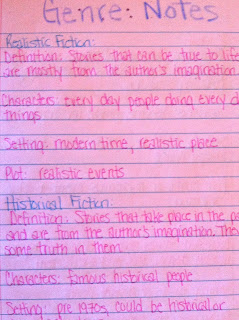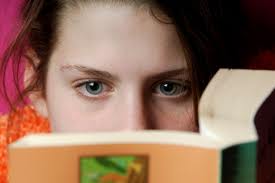In a nut shell, kids need to read books of their choice in order to improve in reading. I always wonder when the love of reading stops. I've been watching my son who is in the seventh grade now to see when he will begin to dislike reading. So far so good, but he doesn't seem to read as much as he used to. I tack that up to how busy his life has become with football practice and games, school, homework, church youth group, and family. However, there were times last year when he would come home and tell me what a boring story they were reading in English. He would do well on the tests, but some of the stories just weren't grabbing his attention and keeping it. I think our children begin to dislike reading when they have to read a story, answer questions about that story, and then take a test about the story.
I understand that with high stakes testing and grade level curriculum that most of us feel we have to teach reading this way. This year I'm expected to teach The Odyssey, Romeo and Juliet, Hamlet, To Kill a Mockingbird, Night, and Left to Tell. And I will teach them. But in addition I'm trying something new - for me. The Reader's Notebook.
Each student purchased a composition notebook for the year. The notebook is divided up into the following sections: Table of Contents, Books I've Read, Someday Books, Genre Notes, Guidelines for Reading Workshop, Letters to Mrs. Wallace, Book Recommendations, Other Important Information.
In the books I've Read section students list the number of the book (whether it's their first book or their 20th), title, author, genre, date completed, and if it's Easy, Just Right, or Challenging. I had them begin their list with the summer reading book. Each student had to read either Quicksilver or Quiver by Stephanie Spinner. I'm setting the bar at 18 books for the year that each student must read. That's nine each semester. Breaking it down even further that's four books the first and third nine weeks and five books the second and fourth nine weeks. I think we can handle that. Yes. I said WE. I'm reading too and have my own Reader's Notebook.
In Someday Books students write the title, author, and genre of books that sound interesting to them, and they might want to read some day. Each week I give a book commercial about two to three minutes. Brief. Students will be doing book commercials as well beginning the second nine weeks. If a student hears about a book they want to read they add it to their Someday list. This way when they finish with their current book they can refer to their list and select their next book.
The Genre Notes are just that. Notes on different genres. Here are the genres I chose to use. Traditional Literature, Fantasy, Science Fiction, Realistic Fiction, Historical Fiction, Mystery, Adventure, and Biography, Autobiography, and Memoir. I chose these because most of the books on my classroom shelves can be easily distributed among these genres. After we discussed the different genres and they wrote the definitions in their Reader's Notebook, I had each class take the tubs of books off of my shelves and categorize them by genre. They had no idea that they were putting their notes into practice. They just thought they were helping me organize our library.
The Guidelines for Reading Workshop was a handout that we cut apart and glued or taped into our notebooks. This is information about reading requirements, how to choose a book, how to write a friendly letter, how to proofread, suggested topics for their letters, due dates for their Reader's Notebooks, and the rubric for grading their Reader's Notebook.
At the completion of each book my kiddos will write me a letter. It must be three paragraphs in length. It must also tell me something important about their story; not just plot development. I've given them a huge list of ideas to write about their book. Here a just a few examples: How did the main character change throughout the book? Describe in detail the setting of your book and how it fits with the story? Who was the culprit and explain how he/she was a good choice. Explain how the book reminds you of yourself, people you know, or of something that happened in your life. Do you agree with the point the author is making and why? ... Some of these I thought up on my own, but others I begged and borrowed from other teachers.
In Book Recommendations students will obviously write a book recommendation about each book they complete. They will initially write it in their Reader's Notebook, but then they will also type it up and print it out so we can add it to our classroom binder of Book Recommendations. This binder is just one more place students can go to find a good book to read.
I'm keeping the Reader's Notebooks in containers by alphabetical order in my classroom. They sit on the bookshelf. Students may get their notebooks at any time during independent class time to work in them. The containers also make it easy for me to carry the notebooks home since they have a lid with a handle.
So how are we going to read all of these books? We read for the first 10 minutes of class each day. On block day once a week we read for 20 minutes. So that is 50 minutes each week. My students know when they come through the door that they have entered the ZONE and must quietly sit down, get out their book of choice, and READ. They also read whenever they complete their assignments, quizzes, or tests. Plus I ask them to try to read for 30 minutes each night of the week. After I take attendance, I read with them. This coming week, I'm going to begin circulating around the room each period and ask what they're reading and where they are in the book.
So far, just through my observations the majority of my kiddos are reading and in the zone. I have a few that read for awhile and then stare at the wall. I've placed several different books into their hands, but as of yet nothing has hooked them. I'll keep trying to find just the right book for each of them.
What I like about the Reader's Notebook besides all of the reading is that students will also be writing. Writing letters to me about their books is like writing a literary analysis. Writing book recommendations is persuasive writing. They're writing about their reading. LOVE IT! Of course this won't be all of the writing they will do this year. I also like the conversations that have already been happening in class. My kids are talking about and sharing their books! Can you believe it?! "This is such a great book. You've got to read it." "I'm at the part where..." "Can I read it after you?"
I pray this works. I want my kids to fall in love with books all over again or maybe for the first time. I want their reading to improve. Please keep your fingers crossed.
Update: Reader's Notebook Turns Blog - A Teaching Moment








































